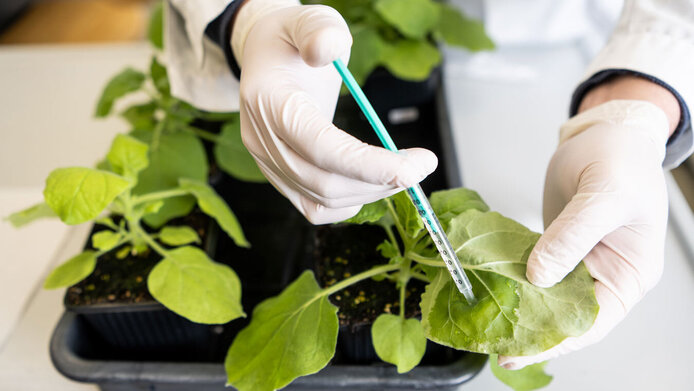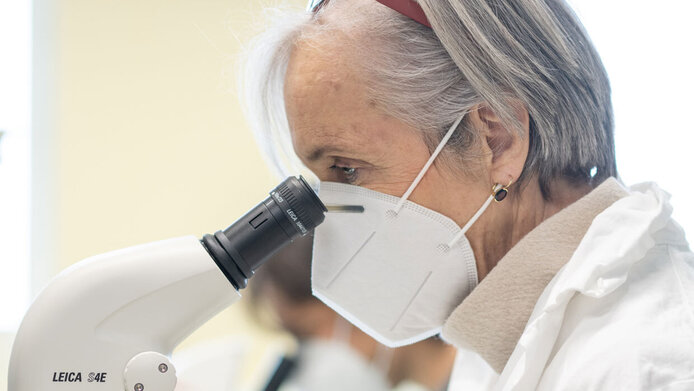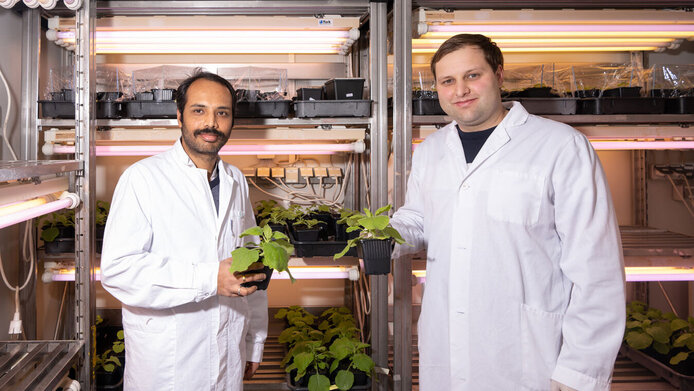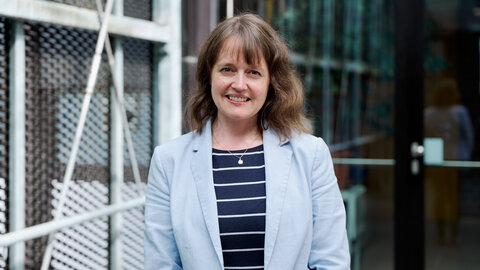Here’s a tobacco plant that saves lives
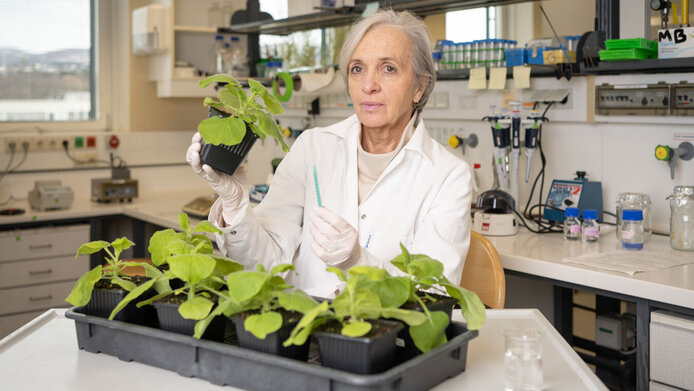
Its leaves are medium size and light green, it arrived in Europe in the 15th century and it is related to the potato and the tomato. At Vienna’s University of Natural Resources and Applied Life Sciences, this nightshade plant is kept in a so-called “climate chamber”–- at 60 percent humidity and a constant temperature of 22 degrees. These are optimal conditions for Nicotiana benthamiana, a tobacco plant. “Smoking kills” says the warning label on many a cigarette packet. In the way Herta Steinkellner uses it for science, the opposite is true: this tobacco plant can save lives! It produces highly effective human antibodies against diseases such as cancer, Ebola and – most recently – Covid-19.
Genetically modified tobacco plant
Nicotiana benthamiana has to be genetically modified to make it produce foreign proteins in addition to its own. These include antibody proteins that are normally produced in the human body as a reaction to pathogens. The method involves introducing the genes that contain the blueprint for human antibodies into the plant. “We do this by using a bacterium as a kind of taxi. The plant then uses this blueprint to assemble the specific human proteins,” explains Herta Steinkellner. In this way the plant can produce antibody proteins that can subsequently be used as medicines for humans.
Personal details
Herta Steinkellner is a professor at the Department of Applied Genetics and Cell Biology at the University of Natural Resources and Life Sciences (Boku) Vienna. After graduating in biology from the University of Vienna, she completed her doctorate and professorial qualification in molecular biology and genetics at the Boku. From 2010 to 2017, she headed the Laura Bassi Centre of Expertise “Plant Produced Proteins” in Vienna. Research stays and visiting professorships have taken her to the UK, the USA and Japan.
Boundaries between living beings are blurred
“This approach is possible because – at molecular level – human and plant cells are very similar, since the genetic code is universal, from single-cell organisms to mammals,” explains Steinkellner, a professor at the Department of Applied Genetics and Cell Biology at the University of Natural Resources and Life Sciences (Boku) Vienna. At the genetic level, the boundaries between plant and animal cells are also blurred.
“We were pioneers”
Although biopharmaceuticals – the best-known among them being antibodies – are normally produced in animal cells, this is a time-consuming and very costly process. For that reason, 25 years ago researchers at the University of Natural Resources and Applied Life Sciences began to explore an alternative production route using plants. “We were pioneers back then,” remembers Steinkellner with obvious enthusiasm. She conducted her research as a doctoral student under Hermann Katinger, then head of the Department of Biotechnology and founder of the Polymun company, whom she describes as a visionary: “Katinger was already working on HIV in the 1980s. One of the first antibodies to be clinically tested came from his laboratory.”
Antibodies against Ebola
As a professor at the Department of Applied Genetics and Cell Biology, Steinkellner soon focused on protein modulation: if one modifies the chemical attachments of proteins (e.g. the sugar residues), their effect will change. “We soon found that the antibodies we developed against HIV were more effective than those derived from animal cell cultures.” The same was true of antibodies against the Ebola virus. Although their high effectiveness was quickly recognised, the world was not interested in research on Ebola for a long time. In 2008, Steinkellner started collaborating with a US biotech company that had the Ebola medication tested on animals.
2014 Ebola epidemic
Steinkellner was on her way home from a research stay in the USA when her American cooperation partner got the go-ahead to start human testing of the Ebola medication for which she developed the production technology. The first clinical trials were about to begin. “When I got off the plane in Vienna a few hours later, thousands of infected people would have already needed the drug,” she recalls. That was in the summer of 2014, when the Ebola epidemic that had broken out in West Africa at the beginning of that year had hit western news media. On 8 August 2014, the World Health Organisation declared the epidemic a “public health emergency of international concern”. This virus was to prove devastating, killing one in every two infected individuals.
First use of antibodies in humans
A few days later, on 12 August 2014, the WHO declared – for the first time in its history – that the use of experimental but not yet approved drugs to fight the epidemic was ethically justifiable. “This was the first use of antibodies in humans in this context. We had been working on that for years without arousing much interest. And suddenly it couldn’t happen fast enough,” Steinkellner recalls. Public interest in her research skyrocketed as the roots of the Ebola drug “ZMapp” were growing in her laboratory.
Antibodies against SARS-CoV-2
Six years later, a new virus appeared that has been holding the entire world hostage for two years now. And once again, Herta Steinkellner produces newsworthy results: her research group has succeeded in generating antibodies against the SARS-CoV-2 coronavirus, more precisely two subtypes of antibodies of great interest, so-called IgG3 antibodies and IgA antibodies. The latter are promising because they are active in the mucous membranes – the ports of entry for SARS-CoV-2 – and could enable treatment via nasal sprays. “Some financially potent companies are already active in this context,” is Steinkellner’s comment on the application side.
50 times more powerful in the fight against the virus
The IgG3 antibodies for their part are even more interesting. “Their production is a very complicated matter, but we managed it with a lot of commitment from the staff,” reports Steinkellner, who holds the patent for this trailblazing achievement. She notes that the special benefit of this subtype lies in its high effectiveness in combating SARS-CoV-2, which a study in the scientific journal PNAS has confirmed: “IgG3 is 50 times better at neutralising the virus.” The problem, however, is the instability of the antibody: “At the moment, they tend to ‘crumble’ within a few days.” Intensive further research is required to overcome this stumbling block so that a manufacturing process can be developed.
Teacher, doctor or lawyer
Steinkellner’s path to biotechnology was actually a matter of pure chance – and love at first sight. As a child, Steinkellner, who is now 63, already knew that she wanted to attend university. Growing up in a small Carinthian village, there were only three academic role models for her: teacher, doctor or lawyer. She decided to become a biology teacher and moved to Vienna for her studies in the late 1970s.
Love at first sight
A part-time job during her studies in a genetics laboratory at the Vienna General Hospital gave her a first insight into the fascinating world of genetics. “This was the first time I saw that a cell really looks like the picture in the books,” she recalls. Her passion was awakened when what she had learned theoretically suddenly became visible in real life. When Steinkellner came to the Institute of Biotechnology at the Vienna University of Natural Resources and Applied Life Sciences as a young student assistant in the 1980s, it was “love at first sight” and she was infected by the spirit of optimism reigning there. She was hooked for good and her fascination has not waned ever since.
Lifelong mentoring
After completing her thesis, the young researcher specialised in molecular biology and found a mentor in the department’s founder – and then director – Josef Glössl, who showed her new fields of research and provided a productive research environment. “I have always had great colleagues. Our scientific field thrives on teamwork and networking,” she notes. Steinkellner sees her own role as a doctoral supervisor as providing “lifelong mentoring”. One example: she was recently asked for a letter of recommendation by a former postdoc who has been working in the US for the past ten years. “I remain their motherly supervisor forever and always,” she laughs.
Not enough recognition and support of talents
One of her former students, the US-based virologist Florian Krammer, became widely known during the coronavirus pandemic through his numerous media interviews. He is one of those excellent researchers who were educated in Austria but have made a career abroad. “It is a pity that such top scientists often have little opportunity to carve out a career in Austria,” Steinkellner says wistfully. According to her, one of the reasons is that talent is not recognised and promoted enough in this country. She would also like to see basic funding for additional staff for every professorship such as one finds in many Western countries. “In Austria, that is clearly lacking. As a result, many people, even talented ones, drop out of research because gaps in funding can occur. Unfortunately, it is difficult to catch up again when that arises,” says Steinkellner.
Not enough recognition and support of talents
One of her former students, the US-based virologist Florian Krammer, became widely known during the coronavirus pandemic through his numerous media interviews. He is one of those excellent researchers who were educated in Austria but have made a career abroad. “It is a pity that such top scientists often have little opportunity to carve out a career in Austria,” Steinkellner says wistfully. According to her, one of the reasons is that talent is not recognised and promoted enough in this country. She would also like to see basic funding for additional staff for every professorship such as one finds in many Western countries. “In Austria, that is clearly lacking. As a result, many people, even talented ones, drop out of research because gaps in funding can occur. Unfortunately, it is difficult to catch up again when that arises,” says Steinkellner.
More interfaces needed
From 2010 to 2017, Steinkellner headed the Laura Bassi Centre of Expertise on “Plant Produced Proteins”. Many new scientific tools were developed there, and they subsequently migrated successfully to applied research. In Austria, she misses precisely such an interface between basic research and application. “There used to be the so-called translational programmes of the FWF. Unfortunately, this splendid funding route was discontinued, leaving a big funding gap. That structural problem surfaces in one out of every two strategic discussions we have.”
Networking and teamwork
Steinkellner explains that she benefitted greatly from each of her own research stays in the UK, the USA and Japan. “I have brought something back from every waystation that has taken me a step further: a new tool, experience, but also widely branching networks of people that are still of benefit to my research group today.” Steinkellner believes that networking and teamwork are indispensable in the natural sciences. She perceives her own work as representing the result of the efforts of many people: bosses who create a fertile environment and collaborators who put ideas into practice. As she puts it very concisely: “In my discipline the days of lone warriors are over!”
